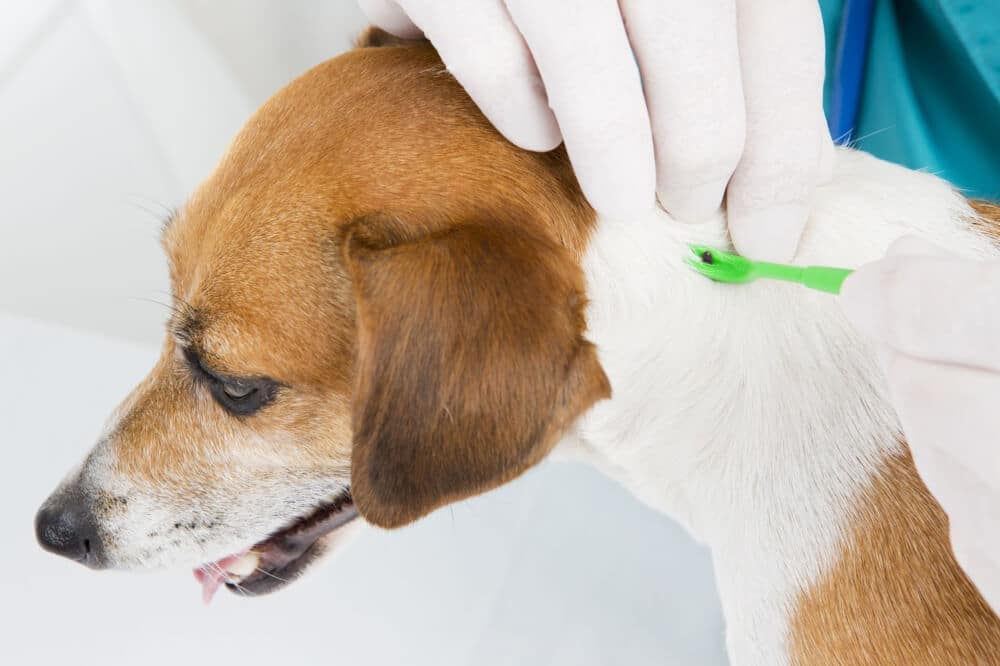Do you know the difference between fleas and ticks? If not, you’re not alone. Many people cannot identify the differences. Fleas are tiny black bugs that jump and feed on blood, while ticks are brown or black and do not jump. So what’s the big deal? Well, both of these pests can transmit diseases to your pets, so it’s crucial to be able to identify them and take steps to prevent them from infesting your home. Keep reading for more information on fleas vs. ticks.

What Are Fleas?
Fleas are tiny insects that feed on the blood of mammals and birds. There are around 2,500 species, but they all have one thing in common: an unpleasant bite! They are tiny, brown vermin that live on dogs and cats. Fleas grow to about 3 millimeters (1⁄8 inch) long with a flat body enabling them to move through the host’s fur efficiently.
What Are Ticks?
Ticks are tiny parasites that live by feeding on mammals and birds. Adult ticks are small, ranging in size from 3 to 5 mm. They can be hard to spot, but they can cause many problems if they aren’t removed promptly. The creature’s body is shaped like a pear, with eight legs and blood-filled chambers.
They locate potential hosts by sensing odor, body heat, and moisture in the environment, as well as through vibration sense. Tick bites are a serious concern for humans and other animals. The hematophagous (blood-ingesting) diets of ticks make them key players in transmitting diseases that can affect your pets.
How to Identify a Flea or Tick On Your Pet
Fleas and ticks are two of the most common pests that can infest your dog, and both can cause a lot of discomfort for your pup and transmit diseases. If you suspect your dog has fleas or ticks, it’s essential to identify them and take steps to eliminate the bug.
Characteristics of a Flea
- Small (sometimes difficult to see without a magnifying glass)
- Dark reddish-brown
- Flat
- Six long legs
- Antennae
- Small head compared to bigger body
- Eggs are white, oval-shaped
Characteristics of a Tick
- Brown, reddish-brown, black
- Larval ticks have six legs
- Nymph and adult ticks have eight legs
- Flat and oval appearance
Importance of Knowing the Difference Between a Tick and Flea
Fleas and ticks can be a significant nuisance for dogs and their owners, and these pests can cause skin irritation, hair loss, and even severe diseases. It is essential to tell the difference between a flea bite and a tick bite, so you can take appropriate action if your dog becomes infected.

Symptoms Between Fleas and Ticks
As a dog owner, you know the importance of keeping your furry friend free of fleas and ticks. These parasites can cause serious health problems, so it’s essential to be able to recognize the symptoms of a bite. Below is a list of what a flea and tick bite looks like.
Fleas
- Very itchy.
- A red, swollen lump develops within thirty minutes of the bite.
- The lump begins to turn into a blister or small wound after a day or so.
- Bites are often on legs and feet.
Ticks
- Sore or swelling on the skin.
- Change in skin color.
- When to contact your doctor: rash gets bigger with a bullseye pattern, you cannot remove the tick, flu-like symptoms (fever, chills, muscle/joint pain, fatigue, or headache), deer tick bite (may require antibiotics).
- When to seek emergency care: difficult breathing, heart palpitations, severe headache, paralysis.
Diseases Carried by Fleas
As a dog owner, you know the importance of keeping your furry friend free of fleas and ticks. These parasites can cause serious health problems, so it’s essential to be able to recognize the symptoms of a bite. Below is a list of what a flea and tick bite looks like.
The number of flea-borne disease cases in the U.S is relatively minor, but with increased international travel and expected rising temperatures, more citizens could be at risk for these pest problems.
Types of Diseases Spread by Fleas
- Bubonic Plague: The plague is one of the most notorious diseases in human history, carried by rats and transmitted to fleas that bite pets and humans.
- Murine Typhus: Murine typhus is a rare but severe disease in North America. It occurs when rats get infected with fleas and then carry them into human communities, where they feed on the blood of humans or other animals.
- Allergic reactions: can cause a wide range of responses, including an allergic skin condition called "flea-bite dermatitis."
- Parasite transmission: During grooming, adult fleas infected with tapeworms can be accidentally ingested by dogs.
Diseases Carried by Ticks
Ticks are blood-sucking parasites that can transmit a single type of organism or multiple types to your dog through just one bite. The toxins they release into our pets’ bloodstreams cause them harm, and the bite of a tick is potentially harmful to your dog. If left untreated, these infections can result in organs and tissues becoming inflamed and an abundant number of symptoms that may appear anywhere from weeks after being infected until years later.
Types of Diseases Spread By Ticks
- Lyme Disease: a condition that can affect dogs, including lethargy and lameness. The symptoms of this infection in your pup might include fever or joint pain/swelling along with an enlargement (or swelling) around nodes in their neck area.
- Rickettsial Diseases: Rickettsia bacteria are a type of microbe that can cause illnesses in dogs, including Rocky Mountain Spotted Fever, Ehrlichiosis, and Canine Anaplasmosis.
- Canine Bartonellosis: Less common than some other tick-borne diseases we see in dogs, the symptoms can be severe. Lameness and fever are two symptoms. However, if left untreated, it can lead to severe conditions such as heart or liver disease.
- Canine Anaplasmosis: The symptoms include lethargy, loss of appetite, and stiff joints, to name just a few; in more severe cases, it could lead to seizures too.
- Canine Ehrlichiosis: Symptoms of this condition typically begin one to three weeks after your dog has been infected and may include bruising, fever, poor appetite, or nosebleeds.
Treatment for Both Fleas and Ticks
Several treatments are available to help you get rid of these pests; some are more effective than others, so it’s important to do your research before choosing a treatment.
Fleas
- Tablets that the animal can swallow.
- Powders or solutions are applied to the fur.
- Treatment for tapeworms as fleas can carry this parasite and pass them onto other animals in their bite.
- A licensed pest control operator can determine the type, source, and extent of your infestation before using registered insecticides to control fleas. The treatment MUST be safe for pets.
Ticks
- Tick sprays: a bit more work as you will need to cover the entire body with the spray.
- Powders: easier to use than sprays, but messier. They are not recommended for dogs with asthma.
- Shampoos/Dips: used to treat after ticks are found.
- Tick collars: Unlikely useful for dogs who like swimming because they become less effective after getting wet.
Talk with your vet if you are looking for ways to protect your furry friend from ticks. They can give insight into the best treatment for your situation!
Prevention Tips for Both Types of Pests
Are you worried about fleas and ticks? You’re not alone. Fleas and ticks are common problems for dogs, but you can help keep them under control. Here are some of the best ways to prevent fleas and ticks from making your pet miserable.
How to Prevent Fleas
- Good hygiene practices, such as regular house cleaning and professional pest control services, can reduce the risk of infestation in your home.
- Limit contact with wild and stray animals.
- Ask your vet about flea control products.
- Brush and bathe your pup regularly.
- Monitor the amount of time spent outdoors.
- Check regularly for fleas.
How to Prevent Ticks
- If you go for a walk in the woods or fields, check your dog's skin often. Ticks like to settle between toes and around the face and ears; sometimes, they'll latch on somewhere else, like an armpit or groin area.
- A wide-tooth comb is a great way to remove ticks from your dog after being outside for an extended period. Ticks love hiding in thick coats; the comb will help you detect them before they attach themselves.
- Mow the lawn regularly to ensure it's not an attractive place for ticks to live!
- Pet-approved insecticides may be used on your lawn to control ticks, but their benefits are limited because some of these pests spend part of their lifecycle underground.
Fleas and ticks can be a nuisance, but they are also potentially dangerous to your pets’ health. It is crucial to know the difference between the two types of pests, how to treat them, and how to prevent them from returning.
0











